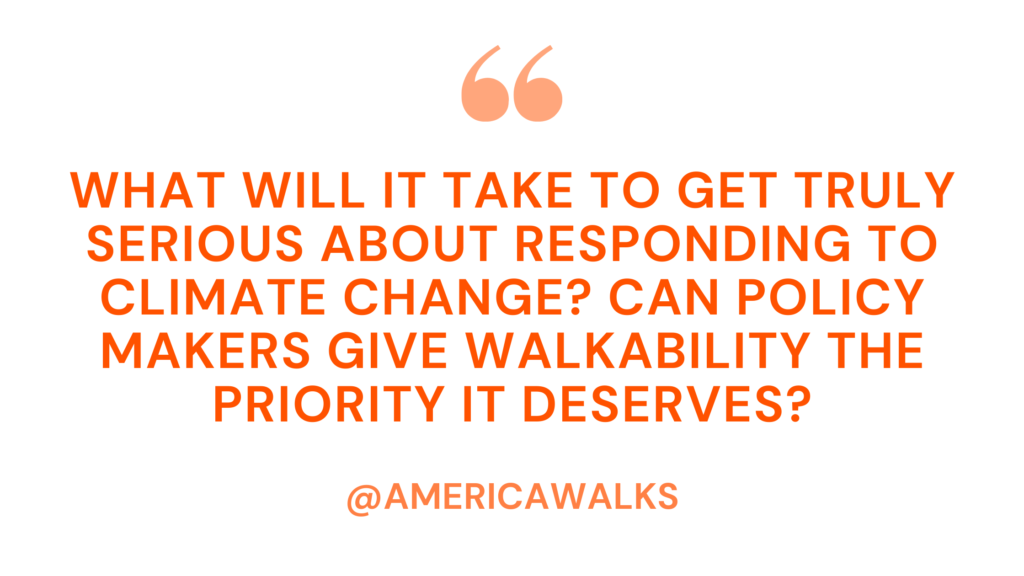What will it take to get truly serious about responding to climate change? And can policy makers give walkability the priority it deserves in that response?
Right now we are seeing record-breaking drought, temperatures, wildfires, and flooding. And that is compelling Americans to identify climate action only behind the pandemic as a priority issue
Yet even though transportation is the single largest source of US carbon emissions – 29% of the total – policy makers (and many advocates) have a particular blind spot to walkable and accessible communities as a solution.

The U.S. Senate right now does not even appear able to abandon the highway expansion spree that has led us to this sorry state. That’s why we have urged you to contact your federal legislators to support House INVEST Act provisions that prioritize safety, equity and climate.
But at America Walks, we think the problem is deeper than even the best solutions currently being considered in Congress. Much of the thinking on transportation by our leaders appears to center on the assumption that we will replace car trips powered by fossil fuels with car trips powered by electricity or trips on transit. To them, walking (and other active transportation modes) are simply not real transportation.
The scale of the climate challenge (we must get to zero emissions) and the speed of the response (deep reductions now) means we can’t leave a simple, affordable and zero emission strategy on the table. Getting more people into walkable and accessible communities is a complementary strategy to taking gas guzzlers off our streets. And it does not require a massive investment in charging stations, deep subsidies for vehicles, or mining and transport of the raw materials that make up electric vehicles.
Imagine if we simply rewrote the laws that separate the places we live from the places where we want to go. Right now our zoning laws rigidly exclude housing, stores and jobs from places that were built from the ground up to be walkable. Where there are jobs nearby, the private sector would build missing middle housing and entrepreneurs would build corner stores, because people gladly pay to live in such neighborhoods. Just take a look at housing prices in mixed use neighborhoods near jobs. And this is not just an urban issue. Iconic small towns were built around the idea that a resident could walk to church, school and markets. Yet we have gradually made traditional town and neighborhood design illegal in favor of creating car dependency and the deep costs that come with it.
Policy makers probably believe it is too hard politically to change zoning. But we are seeing a rising tide of opinion, and action in city after city, that we can’t seal our communities in amber when there is such a deep need and demand for walkable accessible communities. State and federal governments should be doing all in their power to encourage local communities to get with the times and support infill housing and active transportation.
Achieving this vision will also mean investing money to convert some of our right of way to prioritize walking, rolling, biking and local transit. But that will cost much less than the billions we spend on a highway expansion spree that makes reaching our climate goals even harder.

If you are reading this, you probably already believe in our mission to make pedestrians safer, improve health, and give people of all ages and abilities the opportunity to share in community life. But with rising public concern about climate disruption, now is a great time to let your community and elected leaders know that walkable communities are an essential part of a climate response. And it’s time to rethink what we believe is possible, because the alternative, an increasingly hostile climate, is yet more unthinkable.